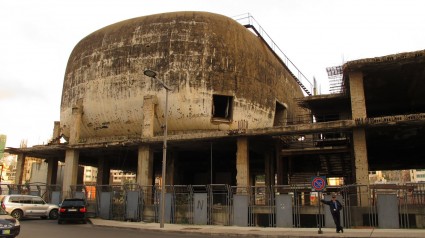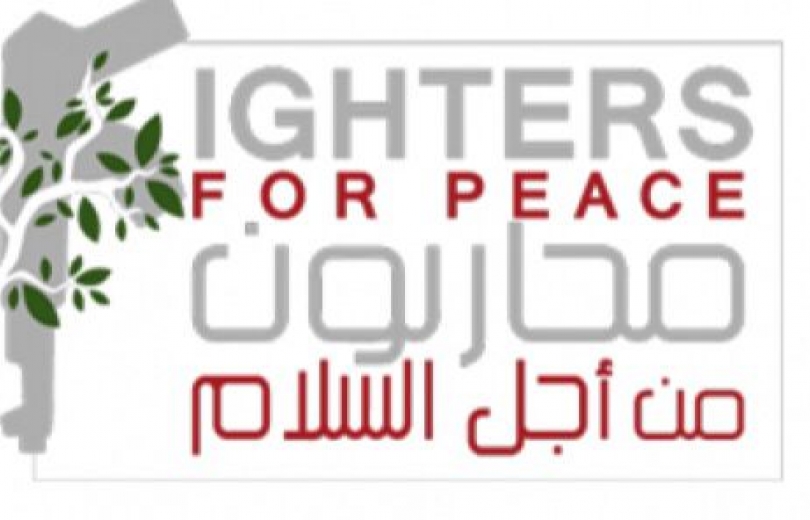
Memory at Work is a database centered primarily on the history and recollections of the Lebanese wars = ديوان الذاكرة اللبنانية
Click here to search for documents and articles on selected topics from War & Postwar times.

الحرب الأهليّة اللبنانيّة: عن المتاريس المستمرّة. في الذكرى 41 لاندلاع الحرب اللبنانية، تقدّم الآداب هذا الملف الذي يتراوح بين المقالة والشهادة.

سنوات الحرب الاهلية اللبنانية في الكوميكس كما سردتها لينا مرهج في شباب السفير ِ ٠٩/٠٤/٢٠١٣
Badna Naaref is a call for dialogue about the country’s wartime experiences among different generations of people who live in Lebanon.

Projects on commemoration sites: Lebanese students from twelve schools present projects on commemoration sites and important events of the Lebanese civil war.
ملحق خاص صادر عن مشروع «بناء السلام في لبنان» التابع لبرنامج الأمم المتحدة الإنمائي. يجمع الملحق عدداً من الكتّاب والصحافيين والإعلاميين والباحثين والفنّانين المقيمين في لبنان، ويعالج في هذا العدد ذكرى الحرب الأهلية

"محاربون من أجل السلام "هي المنظمة الوحيدة في لبنان التي تجمع محاربين سابقين من خلفيات سياسية ودينية واجتماعية مختلفة

UMAM D&R: a citizen resource center focused on Lebanon’s conflict-laden and war-loaded past

ACT for the Disappeared: a Lebanese Human Rights organization created in 2010. Deals with the missing and forcibly disappeared persons during the Lebanese war (1975-1990)

Fushat 'Amal is a digital repository of information about the missing people during the Lebanese civil war.

Timeline: Major events of the Lebanese Civil War (1975 - 1990)
February 26: Assassination of Maaruf Saad in Saida, while he was leading a protest against plans to privatize the fishing sector in Lebanon.
April 13: Ain-al-Rumannah incident. A bus carrying Lebanese and Palestinian civilians was attacked. 27 passengers were killed and 19 wounded.This was claimed as a retaliation to an earlier attack on a church in the same area.
October 24: Battle of the Hotels that lasted several months. These street battles started in Beirut defining demarcation lines which, divided the city into East and West sides.
December 6: Black Saturday, sectarian violence spread. By the end of the day, at least 300 Muslims and an equal number of Christians have been murdered on arbitrary roadblocks.
January 5: Sieges of Tal al-Zaatar Palestinian camp by the Lebanese Front.
January 18: Karantina Massacre: Right-wing Christian forces like the Guardians of the Cedars, the Phalangist and the Tigers Militia took control of the Karantina district. Hundred of Palestinians were killed and the inhabitants fled before the shantytown was burned and bulldozed.
January 20: Damour Massacre: Palestinian guerrillas and the National Movement attacked and destroyed the Christian populated town of Damour south of Beirut. Hundreds of people were killed and thousands were displaced.
January 21: Lebanese Arab Army (LAA) was formed under the leadership of Lieutenant Ahmed al-Khatib and represented Muslim officers and soldiers who defected from the army of Lebanon and accused its Maronite leadership of collaboration with Maronite right-wing militias.
June 1: Syrian army enters Lebanon and stops the vast military gains of Palestinian guerrillas and the Muslim forces against Christian militias.
August 12: Tal-al-Zaatar camp siege ended and the camp fell in the hands of Christian militias. Thousands of Palestinians died in the siege and its aftermath.
October 21: Cease-fire agreement: A cease-fire was agreed upon following the Arab Summit in Riyad (November 16-17). The Arab Deterrent Force (ADF) was formed. Syria was accorded the predominant role in the ADF, which was to be a peacekeeping body and to maintain the cease-fire.
March 16: Assassination of Kamal Joumblatt, leader of the National Movement.
March 17-19: Massacres against Christian civilians in the Chouf villlages of Barouk, Botmeh, Kfarnabrakh, Mazraat el-Chouf, Maasser el-Chouf, Machghara and Brih, in reaction to the assissination of Joumblatt.
March 14-15: Israel invades South Lebanon claiming retaliation for a PLO fighters attack into its territory. Israeli army push up as far the Litani river, approximately 40 km north of the Israel-Lebanon border.
March 19: United Nations Security Council Resolution 425, which calls on Israel to withdraw from Lebanese territory and creates a 6,000-man peacekeeping force called UNIFIL to ensure it happens. Israel withdraws and passes control of the land to its proxy army, the pro-Christian South Lebanon Army (SLA).
June 13: Massacre of Ehden by a Phalangist commando, killing Tony Frangieh and his family members and bodyguards.
September 17: Camp David Accords between Israel and Egypt, the first Arab-Israeli peace. Palestinians in Lebanon vow to escalate their attacks on Israel.
Series of battles to unify the Christian forces under the leadership of Bashir Gemayel.
June 6: Israeli invasion: Israel invades Lebanon and reaches the southern suburbs of Beirut.
August 23: Bashir Gemayel elected president of Lebanon.
August 24: A multinational force of U.S. Marines, French paratroopers and Italian soldiers lands in Beirut to assist in the evacuation of the Palestine Liberation Organization fighters.
August 30: PLO forces evacuate Lebanon, under the supervision of US-French-Italian forces. Yasser Arafat leaves Beirut for Tunisia.
September 10: Multinational force completes its withdrawal from Beirut.
September 14: Lebanese President-Elect Bashir Gemayel is assassinated at his headquarters in East Beirut.
September 15: Israeli forces invade Beirut after asking civilians to leave the city.
September 17-18: Sabra and Shatila massacre, Christian militia killed about 1,000 Palestinians in the Israeli-controlled area of Sabra and Shatila refugee camps, prompting the return of a multi-national U.S., French and Italian peace-keeping force.
September 21: Amin Gemayel, Bashir Gemayel's elder brother, elected president.
April 18: Suicide bomb attacks on the United States embassy in Beirut, killing 63 people.
May 17: May 17 Agreement, Lebanon signs a withdrawal agreement with Israeli which provided a framework for the establishment of normal bilateral relations between the two countries.
August 31 - September 9: The Mountain war, interconfessional massacres in the Chouf area which resulted in the displacement of Christians from the area.
September: US warships shell Muslim areas of Beirut in support of Amin Gemayel's government.
October 23: Suicide lorry-bomb attack on the US Marine base in Beirut. At least 241 US Marines and 58 French paratroopers are killed.
February 6: An uprising by leftist movements and Afwaj Al-Muqawama al-Lubnaniya (AMAL) took place in West Beirut against the signing of a peace accord with Israel, and seized control of West Beirut.
Spring 1984: Multinational force leaves Beirut after the fall of the Lebanese government. Several westerners are abducted in Beirut, including William Buckley, station chief for the US Central Intelligence Agency (CIA).
March 8: Car bomb near the home of Sayed Mohamed Hussein Fadhlallah, at Bir el-Abed.
March 12: Lebanese Forces under the leadership of Elie Hubayka take control of East Beirut.
May 19: Flag War, AMAL consolidates its power over West Beirut. AMAL begins shelling Palestinian refugee camps in South Beirut.
June 10: The Israeli army finishes withdrawing out of most of Lebanon, but keeps a “security zone" patrolled by the South Lebanon Army and Israeli soldiers.
December 29: The three party agreement was signed by Berri, Joumblatt and Hubayka to end the war under the patronage of Syria.
January: Geagea uprising against the the three party agreement and the expulsion of Hubayka from East Beirut. AMAL continues its attacks on Palestinian camps. Abductions of Westerners continue.
Six Days War, clashes between Shiite and Druze militia in West Beirut breaks the agreement, Syrian troops mobilize to end the clashes and take control of the city.
September 3: National Dialog to end the war started.
January 1987: Terry Waite, special envoy to the Archbishop of Canterbury, disappears in West Beirut while seeking the release of other Western hostages.
May 21: Lebanon cancels 1969 Cairo agreement with the PLO, and also abrogates the May 17, 1983 agreement with Israel.
June 1: Lebanese Prime Minister Rashid Karami is assassinated when a bomb explodes in his helicopter. He is replaced by Selim el Hoss.
Brothers War: clashes between Shiite groups in AMAL and Hizbullah.
September 22: The presidency of Amin Gemayel ends without a successor. Lebanon operates under two rival governments—a military government led by renegade general Michel Aoun, and a civil government headed by Selim el Hoss, a Sunni Muslim.
March 14: War of Liberation : General Michel Aoun declares war against Syrian occupation. Syrian forces, backed by their Lebanese militia allies, respond by besieging East Beirut. Aoun backs down.
September 22: Lebanon's National Assembly meets in Taif, Saudi Arabia. A Document of National Reconciliation is drawn up, which transfers executive power from the president to the cabinet. The previous 6:5 ratio of Christian to Muslims seats in the assembly is adjusted so that an equal balance between members is achieved.
October 22: Taif accord signed.
November 22: President Elect René Muawad, believed to have been a reunification candidate, is assassinated. He is replaced by Elias Harawi. General Emile Lahoud is named to replace General Michel Aoun, commander of the Lebanese army.
January 31: War of Cancelation: General Michel Aoun wages a war against the Lebanese Forces to take over the Christian leadership.
October 13: Syrian air force attacks Michel Aoun from the presidential palace at Ba'abda. Michel Aoun takes refuge in the French Embassy, then chooses exile in Paris.
December 24: Omar Karami heads a government of national reconciliation.
April: The national assembly order that all militias be dissolved by April 30. The assembly permits Hezbollah to remain active. The SLA refuses to disarm.
May 22: A Treaty of Brotherhood, Co-operation and Co-ordination is signed in Damascus by Lebanon and Syria.
July 1: The Lebanese army defeats the PLO in Saida. The army now faces the SLA and the Israelis in Jezzine, just north of the SLA's so-called security zone.
August 26: The national assembly grants amnesty for all crimes committed during the civil war. Aoun gets a presidential pardon and heads for exile in France.